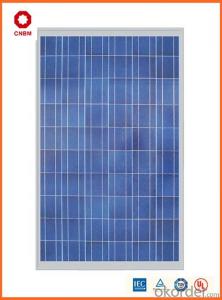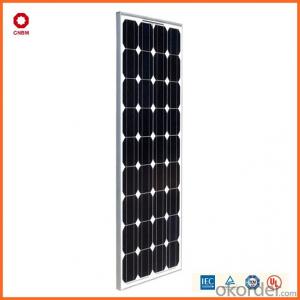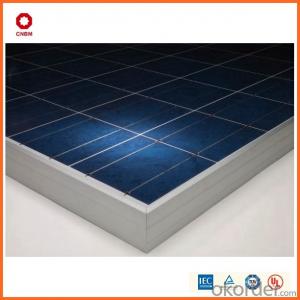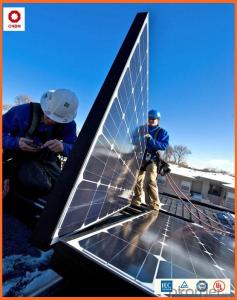135w Small Solar Panels in Stock China Manufacturer
- Loading Port:
- China main port
- Payment Terms:
- TT OR LC
- Min Order Qty:
- 1 watt
- Supply Capability:
- 10000000 watt/month
OKorder Service Pledge
OKorder Financial Service
You Might Also Like
Item specifice
Product Description:
Hot Sale !!! Quality and Safety of Small Poly Solar Panel 5w~150w
1. Rigorous quality control meets the highest international standards.
2. High-transmissivity low-iron tempered glass, strong aluminium frame.
3. Using UV-resistant silicon.
4. IS09001/14001/CE/TUV/UL
Warranties of Small Poly Solar Panel 35~85w
1. 10 years limited product warranty
2. 15 years at 90% of the minimal rated power output
3. 25 years at 80% of the minimal rated power output
Specification
Characteristics of Poly solar panels CNBM (245-320W) | |||||
Max Power Voltage Vmp(V) | 30.3 | 30.8 | 31.1 | 31.4 | 31.85 |
Max Power Current Imp(A) | 7.60 | 7.64 | 7.73 | 7.81 | 7.85 |
Open Circuit Voltage Voc(V) | 36.1 | 36.6 | 37 | 37.3 | 37.68 |
Short Circuit Current Isc(A) | 8.50 | 8.55 | 8.65 | 8.75 | 8.85 |
Max Power Pm(W) | 230W | 235W | 240W | 245W | 250W |
Temperature Coefficient of Cells Poly solar panels CNBM (245-320W) | |
NOCT | 45± 2 |
Temperature Coeffucients of Isc | 0.0492 |
Temperature Coeffucients of Voc | -0.3374 |
Temperature Coeffucients of Voc | -0.4677 |
Mechanical Data of Poly solar panels CNBM (245-320W) | |
Dimension | 1638 × 982 × 40 mm |
Weight | 19.5 kg |
No. of Cells and Connections | 60 (6 ×10) |
Tolerance | 0 ~ + 5 W |
Cell | Monocrystalline Cell 156 × 156 mm |
Packing | 624 Pcs/40ft(H) Container |
Limits of Poly solar panels CNBM (245-320W) | |
Operating Temperature | -40 to +85 |
Storage Temperature | -40 to +85 |
Max System Voltage | 1000VDC(IEC) / 600VDC(UL) |
Features of our products:
• High conversion efficiency mono/poly-crystalline amorphous silicon solar cells
• Modules incorporate high performance bypass diodes to minimize the power drop caused by shading
• High transmittance, low-iron tempered glass
• High performance EVA encapsulant to prevent destroying and water.
• AI frame: without screw, corner connection. 8 holes on the frame can be installed easily
• Good performance of preventing from atrocious weather such as wind and hails
• Certifications: CE IEC TUV VDE UL, Class I
• 10 years 90% power output warranty

Shipping of Small Poly Solar Panel 35~85w
By Sea | Delivery from Shanghai or Ningbo seaport |
By Air | Departure from Shanghai Pudong Airport |
By Express | Post by DHL, EMS, UPS, TNT. |
Features of our products:
• High conversion efficiency mono/poly-crystalline amorphous silicon solar cells
• Modules incorporate high performance bypass diodes to minimize the power drop caused by shading
• High transmittance, low-iron tempered glass
• High performance EVA encapsulant to prevent destroying and water.
• AI frame: without screw, corner connection. 8 holes on the frame can be installed easily
• Good performance of preventing from atrocious weather such as wind and hails
• Certifications: CE IEC TUV VDE UL, Class I
• 10 years 90% power output warranty
As a professional Solar Panel manufacturer and Supplier in China, we have our customers come around the whole world and our specialization has got a worldwide recognition. Meanwhile, with our superior quality, competitive price, prompt and excellent service, As main role in trade section of CNBM Group, CNBM International Corporation supplies products including Monocrystalline Solar Panel, Polycrystalline Solar Panel ( multicrystalline silicon Solar Panel) have received and enjoyed famous reputation in many countries and regions in the world.
- Q:Can solar energy systems be used for powering water pumps?
- Yes, solar energy systems can be used to power water pumps. Solar-powered water pumps use photovoltaic panels to convert sunlight into electricity, which can then be used to operate the pump. This makes solar energy an environmentally friendly and cost-effective solution for pumping water in remote areas or off-grid locations.
- Q:Can solar energy systems be used to power boats or yachts?
- Yes, solar energy systems can be used to power boats or yachts. Solar panels can be installed on the roof or deck of the boat or yacht to generate electricity from the sun. This energy can then be used to power the boat's electrical systems, including lights, navigation equipment, and even propulsion systems. Solar power is a sustainable and renewable energy source, making it an environmentally friendly option for powering boats and yachts.
- Q:Can solar energy systems be used for powering industrial manufacturing plants?
- Yes, solar energy systems can be used for powering industrial manufacturing plants. In fact, many industrial manufacturing plants across the world are already utilizing solar energy systems to reduce their reliance on fossil fuels and decrease their environmental impact. Solar energy systems consist of photovoltaic (PV) panels that convert sunlight into electricity. These panels can be installed on the roofs or open spaces of manufacturing plants to harness the abundant solar energy. The electricity generated by the solar panels can be used to power various processes and equipment within the industrial plant, such as machinery, lighting, heating, ventilation, and air conditioning systems. The use of solar energy for powering industrial manufacturing plants offers numerous benefits. Firstly, solar power is a renewable and clean source of energy, which helps reduce greenhouse gas emissions and dependence on fossil fuels. This aligns with the growing need for sustainable practices and reducing the carbon footprint of industries. Secondly, solar energy systems can significantly reduce electricity costs for manufacturing plants. Once the initial investment is made to install the solar panels, the operational costs are relatively low. Additionally, some countries offer incentives and subsidies for implementing solar energy systems, further reducing the financial burden. Moreover, solar energy systems can provide a stable and reliable source of electricity. With advancements in battery storage technology, excess solar energy can be stored and used during non-sunlight hours or in times of high demand. This helps ensure uninterrupted power supply and reduces the reliance on the grid. However, it is important to note that the feasibility of using solar energy systems for powering industrial manufacturing plants depends on various factors, such as the availability of sunlight, the size of the plant, energy requirements, and the initial investment cost. Additionally, some manufacturing processes may require a consistent and higher level of electricity that may not be fully met by solar energy alone. Overall, solar energy systems have proven to be a viable and sustainable option for powering industrial manufacturing plants. Their use can contribute to reducing carbon emissions, lowering electricity costs, and promoting a greener and more environmentally friendly industrial sector.
- Q:Can solar energy systems be used for recreational vehicles or boats?
- Yes, solar energy systems can be used for recreational vehicles or boats. These systems, commonly known as solar panels or photovoltaic systems, can provide a sustainable and renewable source of power for charging batteries and running various appliances on board. They are especially useful for off-grid adventures, allowing individuals to enjoy their outdoor experiences while reducing their carbon footprint.
- Q:Can solar energy systems be used in powering traffic signals?
- Yes, solar energy systems can be effectively used to power traffic signals. Solar panels can be installed on top of the traffic signal poles to generate electricity from sunlight, which can then be stored in batteries for nighttime or cloudy weather use. This renewable energy source reduces dependence on the electrical grid and lowers operational costs, making it an eco-friendly and cost-effective solution for powering traffic signals.
- Q:What is the role of solar energy forecasting in grid integration?
- The role of solar energy forecasting in grid integration is vital for effectively managing the integration of solar power into the electrical grid. Solar energy forecasting provides accurate predictions of solar power generation, enabling grid operators and energy market participants to plan and optimize the operation of the grid. Solar energy is intermittent and variable, as it depends on weather conditions and the position of the sun. Therefore, accurate forecasting of solar power generation helps grid operators to anticipate fluctuations in solar energy supply and plan for potential imbalances between supply and demand. Grid integration of solar energy requires balancing the variability of solar power generation with the overall electricity demand. Solar energy forecasting plays a critical role in this process by providing real-time predictions of solar output, allowing grid operators to adjust other sources of power generation or storage to maintain grid stability. Moreover, solar energy forecasting is essential for the effective utilization of solar power in energy markets. Accurate forecasts enable energy market participants to optimize their trading strategies, determine the optimal dispatch of power generation assets, and manage their portfolio effectively. This helps to reduce the cost of integrating solar energy into the grid and enhances the overall economics of renewable energy. Additionally, solar energy forecasting contributes to the efficient operation of grid infrastructure. By providing accurate predictions of solar power generation, grid operators can plan the deployment and operation of transmission and distribution infrastructure, ensuring that it can handle the increasing penetration of solar energy without compromising grid reliability. Overall, solar energy forecasting plays a crucial role in grid integration by providing accurate predictions of solar power generation, allowing grid operators and energy market participants to effectively manage the integration of solar energy into the electrical grid, optimize energy trading strategies, maintain grid stability, and efficiently operate grid infrastructure.
- Q:Can solar energy systems be used for desalination?
- Yes, solar energy systems can be used for desalination. Solar desalination involves using solar energy to power the desalination process, typically through either solar thermal or solar photovoltaic technologies. This renewable energy source can be harnessed to heat water or generate electricity, which can then be utilized to remove salt and other impurities from seawater or brackish water, making it suitable for drinking or agricultural purposes. Solar desalination offers a sustainable and environmentally friendly solution to address water scarcity issues in regions with abundant sunlight.
- Q:Can solar energy systems be used for powering off-grid sustainable communities?
- Yes, solar energy systems can be used to power off-grid sustainable communities. Solar panels can generate electricity from sunlight, which can be stored in batteries for later use. This renewable energy source is clean, abundant, and can be harnessed in remote areas where grid access is limited. By relying on solar power, off-grid sustainable communities can reduce their reliance on fossil fuels, lower their carbon footprint, and achieve long-term energy independence.
- Q:Are there any risks of electrical overloading with solar energy systems?
- Yes, there are some risks of electrical overloading with solar energy systems. One of the main factors that can lead to overloading is the mismatch between the capacity of the solar panels and the electrical load. If the solar panels generate more electricity than what is being consumed or stored, it can cause an overload in the system. Another risk is that solar energy systems often require inverters to convert the DC power generated by the panels into AC power that can be used in homes or businesses. Inverters have a capacity limit, and if the solar panels produce more electricity than the inverter can handle, it can cause overloading. Additionally, issues with wiring or connection can also lead to overloading. If the wiring is not properly sized or the connections are loose or faulty, it can increase the resistance and cause overheating, which can eventually lead to overloading. To mitigate these risks, it is important to properly size the solar energy system to match the electrical load. This involves considering factors such as the average energy consumption, peak energy demand, and the capacity of the inverter. It is also crucial to ensure that the wiring and connections are done by certified professionals and are regularly inspected for any signs of wear or damage. Moreover, safety mechanisms such as circuit breakers and surge protectors should be installed to prevent overloading and protect the solar energy system from any potential damage. Regular maintenance and monitoring of the system can also help identify any issues early on and prevent overloading.
- Q:I want to put on the roof of the solar system from the building, 100 square meters, daily consumption of 6 to 8 degrees. Some users know how much to install KM? About the cost?
- Recommended to buy solar water heater price per price in the 150-180 yuan, including in accordance with the material and other costs, buy a good look at whether there is a reliable after-sales
1. Manufacturer Overview |
|
|---|---|
| Location | |
| Year Established | |
| Annual Output Value | |
| Main Markets | |
| Company Certifications | |
2. Manufacturer Certificates |
|
|---|---|
| a) Certification Name | |
| Range | |
| Reference | |
| Validity Period | |
3. Manufacturer Capability |
|
|---|---|
| a)Trade Capacity | |
| Nearest Port | |
| Export Percentage | |
| No.of Employees in Trade Department | |
| Language Spoken: | |
| b)Factory Information | |
| Factory Size: | |
| No. of Production Lines | |
| Contract Manufacturing | |
| Product Price Range | |
Send your message to us
135w Small Solar Panels in Stock China Manufacturer
- Loading Port:
- China main port
- Payment Terms:
- TT OR LC
- Min Order Qty:
- 1 watt
- Supply Capability:
- 10000000 watt/month
OKorder Service Pledge
OKorder Financial Service
Similar products
New products
Hot products
Hot Searches
Related keywords































